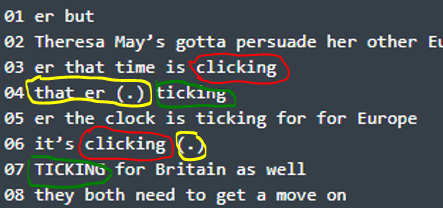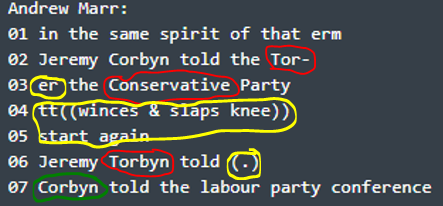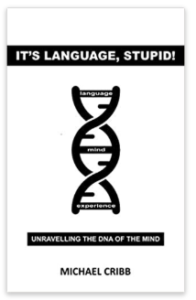Slips of the tongue (speech errors) nearly always include some repair whereby the speaker realises the mistake and then attempts to correct for their error.
The procedure followed for making a repair is typically as follows:
- error detection (sometimes accompanied by truncated word)
- hesitation with filled or unfilled pauses
- correction of error
- (optional comment)
- continuation of speech
This is the minimal procedure for repair and often the attempts to correct the error can lead to more hesitation and/or further errors. In the article I will demonstrate the various parts of the repair procedure using a series of sample. Each sample becomes progressively more complicated in the repair.
Sample 1
In this sample, Boris Johnson erroneously articulates a word blend (polish + colleague). This is followed by a filled pause and then a correction (colleague):

Sample 2
In this sample, Evan Davies selects the wrong word in line 08. There is a brief hesitation (er a ve-) before he corrects the mistake. The correction (very good evening) backtracks two words before the error (line 09). He chuckles to himself and there is some hesitation after the correction which could be attributed to the error.

Sample 3
In this sample, the speaker makes a phoneme insertion in line 01 (NATRO). There is some hesitation including a truncated attempt to articulate the correct word (NA-) and a question to herself (NATRO?). The correct target word is then articulated in 03 and the discourse continues.

Sample 4
In this sample, the speaker substitutes the word ‘clicking’ for the target ‘ticking’ in line 03. After some hesitation he corrects this in 04 but then makes the same mistake in line 06.

Sample 5
In sample 5, Jeremy Hunt makes a word substitution in line 01 (Japanese); his wife is in fact Chinese. He pauses briefly before correcting the error in line 03. However, the consequence of this is an apology and a partial attempt at humour in order to save face in front of the Chinese dignitaries. The discourse from line 02 to 07 is all a result of the error.

Sample 6
The final sample is the most complex and involves three speech errors. The first is in line 02 where Andrew Marr erroneously start to say ‘Tory’ when he intended to say ‘Labour’. Note the truncation of this word (Tor-) as the error is detected early. He then attempts to repair this in line 03 but again selects the wrong word (Conservative). At this, he shows his frustration by wincing and slapping his knee. He then tries to restart the utterance but produces ‘Torbyn’ in line 06, a phoneme preservation from line 02. Howzat! A hat-trick of errors.

Speech errors and repair procedures have been well documented for some time. See Levelt (1983) for an early explanation.
Levelt, WJM (1983) Monitoring and self-repair in speech. Cognition, 14, 41-104




Leave a Reply
You must be logged in to post a comment.